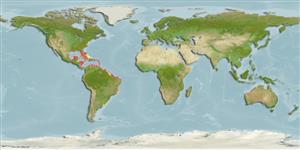Environment: milieu / climate zone / depth range / distribution range
Ökologie
seewasser riff-verbunden; tiefenbereich 0 - 12 m (Ref. 9710). Subtropical; 43°N - 37°S
Western Atlantic: Massachusetts (USA), Bermuda, and the Gulf of Mexico to Argentina.
Size / Gewicht / Alter
Maturity: Lm ? range ? - ? cm
Max length : 50.0 cm TL Männchen/unbestimmt; (Ref. 7251); common length : 35.0 cm TL Männchen/unbestimmt; (Ref. 5217); max. veröff. Gewicht: 560.00 g (Ref. 40637)
Rückenflossenstacheln (insgesamt): 7 - 8; Rückenflossenweichstrahlen (insgesamt): 19-20; Afterflossenstacheln 2-3; Afterflossenweichstrahlen: 16 - 18. Dorsal and anal fins have very long, dark anterior lobes (Ref. 26938). Bluish silver on back, shading to silver on sides, with four narrow dark bars on upper of body (Ref. 13442).
Adults form schools in clear coastal areas, usually near coral formations (Ref. 5217). Juveniles common in clean sandy beaches (Ref. 5217). Adults feed on crustaceans, polychaete worms, insect pupae, mollusks and fishes (Ref. 9626). Between 1995 and 2000, at least 2 specimens were traded as aquarium fish at Fortaleza, Ceará (Ref. 49392).
Life cycle and mating behavior
Geschlechtsreife | Fortpflanzung | Ablaichen | Eier | Fecundity | Larven
Robins, C.R. and G.C. Ray, 1986. A field guide to Atlantic coast fishes of North America. Houghton Mifflin Company, Boston, U.S.A. 354 p. (Ref. 7251)
IUCN Rote Liste Status (Ref. 130435)
Bedrohung für Menschen
Reports of ciguatera poisoning (Ref. 30911)
Nutzung durch Menschen
Fischereien: weniger kommerziell; Aquakultur: kommerziell; Sportfisch: ja
Mehr Information
NamenSynonymeMetabolismusRäuberÖkotoxikologieFortpflanzungGeschlechtsreifeAblaichenSpawning aggregationFecundityEierEientwicklung
ReferenzenAquakulturAquakultur ProfilZuchtlinienGenetikElectrophoresesVererbbarkeitKrankheitenVerarbeitungNutrientsMass conversion
Tools
Zusatzinformationen
Download XML
Internet Quellen
Estimates based on models
Preferred temperature (Ref.
123201): 23.2 - 28.1, mean 27.3 °C (based on 851 cells).
Phylogenetic diversity index (Ref.
82804): PD
50 = 0.5000 [Uniqueness, from 0.5 = low to 2.0 = high].
Bayesian length-weight: a=0.01622 (0.00839 - 0.03134), b=2.83 (2.66 - 3.00), in cm total length, based on LWR estimates for this species & Genus-body shape (Ref.
93245).
Trophic level (Ref.
69278): 4.3 ±0.4 se; based on diet studies.
Widerstandsfähigkeit (Ref.
120179): mittel, Verdopplung der Population dauert 1,4 - 4,4 Jahre. (Assuming tm=2-4).
Fishing Vulnerability (Ref.
59153): Moderate vulnerability (40 of 100).
Nutrients (Ref.
124155): Calcium = 39.6 [14.6, 74.0] mg/100g; Iron = 0.785 [0.387, 1.762] mg/100g; Protein = 20.1 [18.1, 22.2] %; Omega3 = 0.158 [0.081, 0.315] g/100g; Selenium = 12 [5, 27] μg/100g; VitaminA = 40.7 [10.2, 151.3] μg/100g; Zinc = 0.509 [0.300, 0.825] mg/100g (wet weight);
